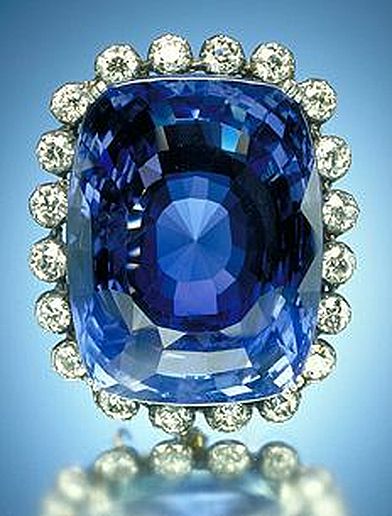The 422.99 carat Logan Sapphire, the second largest known sapphire in the world.
Basics: Sapphire is a variety of the mineral corundum, an aluminum oxide. Other trace elements in the stone can vary its color. Sapphires are most commonly blue, but can also be yellow, green, gray, black, purple, orange, or pink. The presence of chromium creates a red stone, the ruby. Sapphires have a hardness of 9 on the Mohs Scale (diamonds are 10) and are often used in industrial processes such as drilling or cutting. Sapphires are found in many places, principally Madagascar, Australia, Sri Lanka, China, East Africa, and North America (mostly Montana). They are often found together with rubies. Star sapphires exist and these stars usually have either six or twelve points. A variety of sapphire called the color change sapphire appears blue under natural light and purple under incandescent light. These are mostly found in Tanzania. Sapphires are the birth stone for the month of September.
The Black Star of Queensland, a black star sapphire weighing 733 carats.
Associations: Many will recognize sapphire as the stone in the engagement ring given by Britain's Prince William to his wife Katherine Middleton. This ring originally was used by his father, Prince Charles, when proposing to Diana Spenser. Sapphires were previously very common for engagement rings and were seen as a symbol of fidelity and true love. Etymologically, the English word “sapphire” derives from Latin sapphirus, sappirus from Greek σαπφειρος (sappheiros) from Hebrew סַפִּיר (sappir) from Old Iranian sani-prijam, from Sanskrit, Shanipriya (शनिप्रिय), from "shani" (शनि) meaning "Saturn" and "priya" (प्रिय), dear, i.e. literally “dear to Saturn.” The Greek term for sapphire quite likely was misapplied, and instead, used to refer to lapis lazuli. During the Medieval Ages, European lapidaries came to refer to blue corundum crystal by its “sapphire-blue” color, whence the modern name for “sapphire.” It was said to cure anger and stupidity during renaissance times. This stone is also associated with wisdom and mental clarity, hence its inclusion in crowns and ceremonial items used by royalty and religious leaders, including the sapphire of Edward the Confessor in the British Imperial Crown of State and St. Edward's Crown. Because of its blue color it also symbolized a connection with the heavens and was common in rings worn by bishops as well as Hindu religious leaders.
In the Old Testament, Isaiah 54:11 discusses building on a foundation of sapphires. In both Exodus and Ezekiel God is described as resting on sapphires (a pavement of sapphires in Exodus, a sapphire throne in Ezekiel). Some traditions state that the original ten commandments were given to Moses on tablets of sapphire.
Sapphires can focus healing energies toward someone who needs them. They maintain their old Vedic association with the planet Saturn, as well as the blue-tinted Venus. In some healing practices sapphires are associated with healing bleeding disorders such as tuberculosis, nosebleeds, and cardiovascular issues, as well as burns.
The Star of India, 563.35 carats.



No comments:
Post a Comment